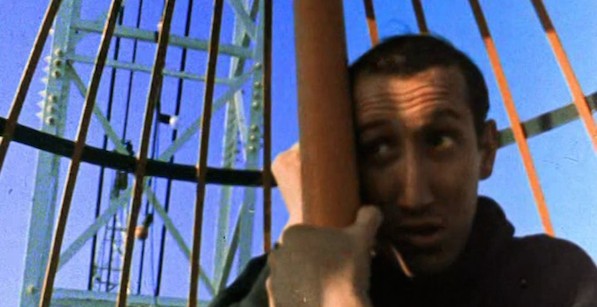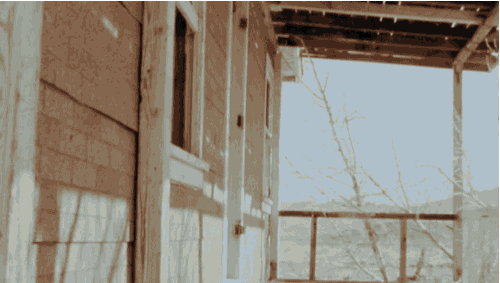With his second feature (the first he had total, freewheeling control over), the late Ray Dennis Steckler earned a small but proud place in movie history, if only for its title: The Incredibly Strange Creatures Who Stopped Living and Became Mixed-Up Zombies!
That was nearly the longest and surely the goofiest monicker yet recorded for a commercial feature in 1964. Explaining himself later, Steckler said he simply thought it would really dominate a theater marquee. (More likely, though, theater owners drastically abbreviated it for signage.)
When Creatures and Steckler were rediscovered by cult film fans a couple decades later, they were duly attracted by that preposterous title, but held by the realization that the same somewhat random, improvisational, none-too-serious tenor ran through all his 1960s films. (It remains for more dogged researchers to determine if he maintained his cheek through the following decade-plus of porn movies directed under pseudonyms.) And the man himself, while he was still around to do interviews and bask in his late-breaking moderate fame, was a hoot.
First wife and frequent star Carolyn Brandt noted in retrospect that she’d always expected he’d get an Oscar one day. Yet Steckler’s career took its quirky subterranean path largely because he wanted to make movies exclusively on his own fun-loving terms—not something you can demand until you’ve reached the top of the Hollywood ladder. So he stayed off that ladder entirely, often writing, producing and acting in as well as directing his own shoestring projects, employing the same circle of friends who in turn employed him when they needed a cinematographer.
It was in the latter capacity that he first entered the industry, after the Pennsylvania native had gotten some camera training with the Army Pictorial Service. Moving to Hollywood in 1959, his first notable job came a couple years later when he replaced a fired DP on gonzo actor Timothy Carey‘s maiden directorial exercise, 1962’s memorably bizarre The World’s Greatest Sinner, where you can find Carey in full flight as a messianic rock ’n’ roller (with young Frank Zappa among his backup musicians, no less).
The same year he took the director’s seat himself on Wild Guitar, one of several early sixties attempts to make a movie star out of pompadoured blond aspiring teen idol Arch Hall, Jr. With the latter’s own producer/manager/scenarist father Arch Sr. cast as an exploitative record-industry honcho, this rock musical did no more for its headliner than did his stabs at horror-fantasy (Eegah), juvenile delinquent melodrama (The Choppers), Cold War satire (The Nasty Rabbit) or western adventure (Deadwood ’76). (It took some time for anyone to realize that young Hall had actually been quite good as a psychotic holding several strangers hostage in 1963’s equally ignored The Sadist, a tense little “B” thriller.)
Steckler enjoyed his new behind-the-camera role, but wasn’t so keen on the Halls’ no-nonsense, stick-to-the-script working methods. (Particularly since that script was nothing you’d want to stick to.) His over-the-top energy and imagination required more freedom. Thus the genesis of Incredibly Strange Creatures, which he co-produced and directed on a budget under $40,000. He also starred under the name Cash Flagg (his principal alter ego amongst many future artistic pseudonyms) as layabout wise guy Jerry, who becomes the latest victim of carnival fortune teller Estrella—under her command he regularly traipses out to murder whoever’s offended her lately, recalling nothing of these deeds afterward.
Billed as “the world’s first monster musical” in “Hallucinogenic Hypervision” (for the spinning op-art wheel Mme. Estrella uses to enslave bozos like Jerry) it also managed to throw in horrible standup comedy and several song ‘n’ dance sequences, including “twist” and “jungle” production numbers.
Happy to hire cheap aspiring talent like himself, Steckler managed to snare as camera operators two recent Hungarian emigres who would become celebrated cinematographers: László Kovács (Five Easy Pieces, Paper Moon) and Vilmos Zsigmond (Close Encounters, The Deer Hunter). The resulting lurid color goulash probably didn’t get any admiring reviews at the time (if it received any at all), but its eccentricities remain endearing. It turned a tidy profit in large part due to Steckler’s inventively shameless marketing ideas, which ranged from retitled re-releases (once as Teenage Psycho Meets Bloody Mary) to having rubber-knife-wielding ushers roam the aisles in monster masks. Here’s Jerry/Steckler himself in hypnotic peril:
The next year he released what would remain his best film, if one still lesser-known than its immediate predecessor. The Thrill Killers was a black-and-white “psycho chiller” that takes a circuitous path around Southern California as various homicidal maniacs (including three mental institution escapees, and Steckler a.k.a. Cash Flagg himself as “Mad Dog Click”) terrorize unlucky passers-by. The screenplay may have its exquisite-corpse elements, introducing and abandoning elements almost at random, yet there’s a sinewy tension and focus here that suggests the director taking his task seriously for once.
Dancer spouse Brandt, who’d appeared in both his prior features, plays one unfortunate victim. But the marquee star was Liz Renay, a glam blonde who’d gained tabloid notoriety as gangster Mickey Cohen’s girlfriend. (She served two years in prison for perjuring herself on his behalf.) This was pretty much the height of her acting career, if not her celebrity, which she’d continue milking for decades. (Viagra) (Married seven times, her autobiography was entitled My First 2,000 Men.)
That resourceful and well-crafted low-budgeter should have led to bigger/better things, but Steckler continued to have trouble finding financing. In true DIY spirit, he turned to glorified home movies, making three shorts casting friends, neighbors and their children in ridiculous adventures that spoofed the popular East Side Kids (later Bowery Boys) programmers he’d grown up on. His own eerie resemblance to rubber-faced beanpole “Kid” Huntz Hall was duly exploited for all it was worth in The Lemon Grove Kids, The Lemon Grove Kids Go Hollywood! and The Lemon Grove Kids Meet the Green Grasshopper and the Vampire Lady From Outer Space. Here’s some typical goofiness from the latter:
These pieces of high-energy, 16mm-shot silliness are still fun to watch, largely because you can tell they were so much fun to make. The series was subsequently strung together into a quasi-feature dubbed Lemon Grove Kids Meet the Monsters. In that same freewheeling spirit, Steckler made 1966’s Rat Pfink a Boo Boo, which starts out as a serious crime drama, then midway abruptly becomes a superhero spoof—allegedly because Steckler simply got bored with making a “straight” film and decided to mix it up a bit. (Those instincts were wise, since the fairly straightforward detective thriller he made in 1969, Body Fever, is neither accomplished or interesting.)
With the beginning of the 1970s, sexploitation was granted freer rein than ever before, providing new opportunities for Steckler as both director and d.p.-for-hire. Thought lost for years, the Texas-shot Sinthia: The Devil’s Doll is an endearing mix of softcore and symbol-heavy psychodrama a la Ingmar Bergman. (To further the ersatz Swedish connection, he took cinematographer credit as “Sven Christian.”) The next year he created a subterranean slasher flick starring Brandt (with their two daughters in prominent support roles) called Blood Shack. But otherwise he spent the Seventies swinging, assuming various pseudonyms to make increasingly hardcore features with such colorful titles as The Mad Love Life of a Hot Vampire, The Sexorcist, Perverted Passion and Sex Rink.
Somewhere in the middle of all this he combined nudity and horror violence in 1979’s The Hollywood Strangler Meets the Skid Row Slasher, in which the former asphyxiator of sexy “photographic models” finds himself strangely attracted to a mousy used-bookstore clerk (Brandt), unaware that she too is a secret homicidal maniac.
By then he and Brandt were divorced, though they remained frequent creative collaborators. By the late eighties, however, he’d mostly shifted out of production and into another branch of the movie industry as a Las Vegas video store owner. After selling that venture in 1995, he devoted himself to re-issuing and promoting his old films for the benefit of newfound fans. When he passed away from heart failure in 2009, cinema lost a willfully marginal, prankish and distinctive personality perhaps best defined by the title of a 1963 short he wrote, directed and starred in: Goof on the Loose.





